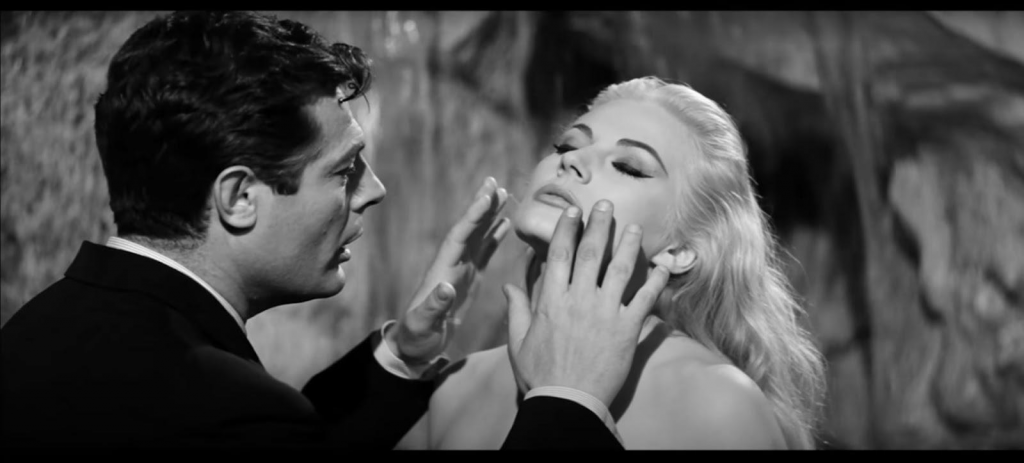By Manisha Thind
Federico Fellini’s ground-breaking 1960 drama La dolce vita is a tale of hedonistic excess and existential angst. La dolce vita is commonly perceived to be a film that turns away from Fellini’s earlier, more neorealist 1950s films depicting authentic Italian life towards ‘the freewheeling fantasias’ of the 1960s and beyond. Throughout the film the diverse and glamourous world of 1950’s Rome, which was rebuilt upon the ruins and poverty of the post-war period, is explored. Fellini charts the massive socio-cultural change and the decline in Catholic morality associated with the rise of hedonistic consumer culture. Fellini has been identified as a ‘humanist on a journey of self-discovery, pursuing meaning on a perilous road’. Indeed, Fellini’s films grapple with larger, philosophical questions on what constitutes a meaningful life, however, his broader goal is to liberate the spectator from ideals, as in role models and ideal ways of living according to society.
The film’s title and its central concern, as in ‘the sweet life’, is rooted in philosophical debates regarding what constitutes ‘the good life’. In the Aristotelian view ‘happiness is the meaning and purpose of life, the whole aim and end of human existence’, which depends upon the cultivation and exercise of virtue. In contrast, the characters in La dolce vita are lost souls wholly ignorant of what constitutes ‘the good life’ – they discern the universe through their senses, and they behave according to observable principles rather than any higher virtues, purpose, or divine plan. In this way ‘existence precedes essence’ in that human beings exist with no predetermined nature or purpose and thus can make freely willed choices and create their own purpose and values in life if they so wish. Indeed, the French-Algerian philosopher Albert Camus, who is commonly associated with existentialism, states that we are all the determiners of the value of our own lives, and we can be happy despite the futility of the human condition. That said, the characters in La dolce vita mostly embody the reproaches made against existentialism, such as: ‘the quietism of despair’, the denial of the seriousness of human life, an overemphasis on the evil side of humanity and a lacking sense of morality
Figure 1
Fellini creates his ‘alter ego’ in a melancholic protagonist, Marcello Rubini (Marcello Mastroianni), who is ‘stifled by introspection’ trying to find meaning in life. Marcello, who once held literary ambitions, is a fashionable gossip columnist reporting on sensational activities around the Via Veneto in 1950s Rome. Despite being ambitious and handsome, Marcello is a morally weak character susceptible to the moral depravity surrounding him. According to Aristotle, a vicious man derives pleasure from bad actions, whilst the incontinent man is inclined to act wrongly and gives in to these inclinations out of weakness; the incontinent man remains dissatisfied with himself despite fulfilling his base desires. Marcello primarily demonstrates characteristics associated with the incontinent man. Marcello has an affair with a wealthy heiress, Maddalena (Anouk Aimée), who is constantly in search of new sensations. Surrounded by a self-indulgent aristocracy, showbiz stars, nouveaux-riches and their assorted hangers-ons, Marcello lives a frivolous life of lust, materiality, and fame. During the Trevi Fountain scene we witness Marcello’s lust towards a famous Swedish-American actress, Sylvia (Anita Ekberg), and yet this is accompanied by frustration as he is not able to attain her and fulfil his fantasy [Figure 2]. If ‘the good life’ concerns living a fulfilled life, as in committing to a higher good or purpose that requires the maximisation of our faculties as human beings, Marcello is not living ‘the good life’ but he is indeed in the search of one. In contrast, those that surround Marcello (and one could say Marcello too) are in the pursuit of honour, the satisfaction of bodily pleasures and the acquisition of material wealth. Vices of deficiency and excess are prevalent, whilst virtuous actions are hardly illustrated. Nevertheless, Marcello faces a struggle of choosing between a life of excess and hedonistic pleasures or an intellectual and virtuous life; these are depicted by journalism and literature.
Figure 2
Marcello holds Steiner (Alain Cuny) in high regard. Marcello has built Steiner up as ‘the ideal man’, as Steiner’s external circumstances (a lavish apartment filled with art, a circle of intellectual friends, a stunning wife and two perfect children) represent what Marcello conceives as la dolce vita and what it means to live ‘the good life’. On the terrace during the soirée of which the high-modernist intellectual Steiner is the host, Marcello asks Steiner to invite him to similar gatherings where the literary, intellectual, and poetic folk are present, proceeding to explain to Steiner that, “Your home is a refuge. Your children, your wife, your books, your extraordinary friends. I am wasting my life. I am not going anywhere. I had ambitions once …” Evidently Marcello’s career as a gossip columnist and leisure time filled with cheap thrills is unfulfilling and instead, he yearns for a more stable life that satisfies his intellectual curiosities. Steiner, however, warns Marcello, responding, “Don’t do what I have done … I fear peace more than anything else. It seems to me like it’s a façade with hell hiding behind it.” Steiner’s response invokes an uneasiness: the spectator feels sorrow and suffering behind Steiner’s composure like the ethical and moral brokenness behind Rome’s glamorous society. These contradicting emotions are present even when Marcello and Steiner return to the soirée: underlying the philosophical discussions that the guests partake in is a general unspoken awareness that these discussions are meaningless.
One could interpret La dolce vita as a film about the death of ‘the sweet [or good] life’, as in ‘the destruction of idealised conceptions of life’. This is exemplified by Steiner’s shocking suicide upon murdering his two children. Fellini suggests ‘a road to inner liberation [by getting] people to accept and love life the way it is, to stop idealising it or conceptualising it, to stop projecting oneself in idealised images on a moral or ethical level’. By creating Steiner as an admirable character and then breaking him down, Marcello is forced to find his own road to inner liberation. Unfortunately, Marcello spirals down into despair and self-loathing. Fellini beautifully captures the atmosphere, culture, and essence of 1950s Rome. Fellini exposes and is enchanted by the superficial yet seductive late-1950s high society moving through the film with an elegant lightness of touch through its characters’ heavy soul-searching odysseys. Although La dolce vita neither features a problem that Marcello must overcome nor a conventionally linear narrative, each episode ‘contributes to building up a mosaic’ which presents a depressing interpretation of Marcello and the society surrounding him. By breaking down the character of Steiner and the idealistic image of Rome’s high society, Fellini encourages us to stop idealising life. My personal take-away from the film is that we must stop searching for ‘the good/sweet life’ and stop projecting ourselves onto the supposedly morally and ethically virtuous ideal people or ways of living; it is the search and projection that stifles us, creates anguish, and makes us unfulfilled. To be happy, liberated and fulfilled we should, in the existentialist sense, create our own values, do what makes us happy and follow our passions despite what others think, say, or do. If we fail, we must not simply “annul ” everything as Marcello does, as we can start again or find meaning in the broken pieces.
Hiya, I am Manisha! I’m from Buckinghamshire, England, and I study MSc Development Management. I write film and documentary reviews. If you want to discuss any of my articles or just talk, you can find me on Instagram (@mani18t) and LinkedIn (https://www.linkedin.com/in/manisha-thind), or email me at m.thind1@lse.ac.uk.



